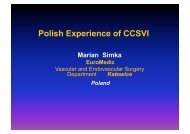ISNVD Abstract Book
ISNVD Abstract Book
ISNVD Abstract Book
You also want an ePaper? Increase the reach of your titles
YUMPU automatically turns print PDFs into web optimized ePapers that Google loves.
A model of filtration and solute<br />
transport across the<br />
Blood-Brain Barrier<br />
Laura Facchini Alberto Bellin Eleuterio F. Toro<br />
Mathematics<br />
Civil and Environmental Engineering Civil and Environmental Engineering<br />
University of Trento (Italy)<br />
University of Trento (Italy)<br />
University of Trento (Italy)<br />
laura.facchini@unitn.it alberto.bellin@unitn.it toro@ing.unitn.it<br />
PURPOSE<br />
Altered venous hemodynamics affects the transport<br />
properties of vessel walls [1], creating microbleed,<br />
perivenular iron stores and hypoxia.<br />
In the present study, we propose a simple<br />
mathematical model for water and solute transport<br />
across vessel wall.<br />
With the help of suitable analytical and numerical<br />
solutions of this model, we investigate<br />
the effect of a blood pressure increase on both<br />
water flow and molecule transport across the<br />
Blood-Brain Barrier (BBB).<br />
1 INTRODUCTION<br />
In a typical (peripheral) microvessel, the lumen<br />
side of the endothelial cells composing the vessel<br />
wall is covered by the glycocalyx, a thin<br />
membrane which is believed to exert a sieving<br />
effect on macromolecules.<br />
Figure 1. Structure of a peripheral blood vessel [modified from<br />
http://www.hubrecht.eu/research/dekoning/research.html].<br />
Since the BBB has the role of protecting the<br />
Central Nervous System (CNS) from the neurotoxic<br />
substances contained in the blood, while<br />
nourishing the surrounding brain tissue, it must<br />
be highly selective. Indeed, the clefts separating<br />
adjacent endothelial cells of the BBB are<br />
partially closed by the tight junctions. Furthermore,<br />
the microvessels of the CNS are protected<br />
externally by the basement membrane<br />
and by the astrocyte feet and the pericytes.<br />
Figure 2. BBB anatomical structure.<br />
Under normal conditions, while macromolecules<br />
cross the BBB through transcellular<br />
pathways [2], water and small hydrophilic solutes<br />
follow paracellular pathways through the<br />
clefts separating adjacent endothelial cells [3].<br />
Figure 3. Paracellular and transcellular transport.<br />
The breakdown of the BBB with the associated<br />
increase of vessel permeability has been observed<br />
in traumatic head injury [4], Alzheimer’s<br />
disease [5] and it has recently been hypothesised<br />
in Multiple Sclerosis ([6], [7]).<br />
2 MATERIALS and METHODS<br />
From the conservation of water and solute mass<br />
in the steady-state case (following [8]) and after<br />
simplifications, we derive the following nonlinear<br />
system of ordinary differential equations<br />
{ (p ′ + rp ′′ ) − σ(π ′ + rπ ′′ )=0,<br />
Aπ(π ′ + rπ ′′ )+rπ ′ (Bπ ′ + Cp ′ (1)<br />
)=0.<br />
Here<br />
• r is the distance from the vessel axis,<br />
• p = p(r) is the hydrostatic pressure,<br />
• π = π(r) is the osmotic pressure,<br />
• σ is the reflection coefficient of the wall,<br />
• A = l p σ 2 −l d , B = l p σ−l d and C = l p (σ−1)<br />
are physiological parameters,<br />
• l p is a permeability coefficient,<br />
• l d is a diffusion coefficient.<br />
Then we calculate<br />
P (r) =p(r) − σπ(r), (2)<br />
q v (r) =−l p [p ′ (r) − σπ ′ (r)], (3)<br />
q s (r) = π(r)<br />
ϕRT [Bπ′ (r)+Cp ′ (r)] , (4)<br />
where<br />
• P (r) is the net pressure,<br />
• q v (r) and q s (r) are the volume and solute<br />
fluxes per unit length of the vessel,<br />
• ϕ is the Stokes radius,<br />
• R is the gas constant,<br />
• T is the absolute temperature.<br />
Now, using the model, we investigate the effect<br />
of an increase of blood pressure p c on both water<br />
flow and molecule transport across the BBB.<br />
Anatomical parameters are obtained from published<br />
studies on electron microscopy observations<br />
of animal brain or mesenteric vessels.<br />
3 RESULT<br />
Figures 4 to 6 show our results in graphical<br />
form.<br />
Figure 4. Volume flux per unit length of the vessel with respect<br />
to the blood pressure p c, with typical venular values of σ and l p<br />
(solid curve), and altered values of σ and l p (dashed curve) simulating<br />
the glycocalyx/BBB breakdown.<br />
Figure 5. Solute flux per unit length of the vessel with respect<br />
to the blood pressure p c, with typical venular values of σ and l p<br />
(solid curve), and altered values of σ and l p (dashed curve) simulating<br />
the glycocalyx/BBB breakdown.<br />
Figure 6. Osmotic (π), hydrostatic (p) and net (P ) pressures<br />
across the vessel wall, with typical values of venular blood pressure<br />
p c (solid curves) and altered values (discontinuous curves),<br />
in both cases of lower and higher than normal blood pressure.<br />
4 CONCLUSIONS<br />
• Blood pressure increase (hypertension)<br />
causes an increase in the volume and solute<br />
fluxes per unit length across the vessel wall.<br />
• The glycocalyx (and thus BBB) breakdown<br />
gives rise to an increase in both fluxes.<br />
• We have depicted the osmotic, hydrostatic and<br />
net pressures across the vessel wall.<br />
• These are very preliminary results and there<br />
is some work on more sophisticated model.<br />
References<br />
[1] Singh A. V. & Zamboni P., J. Cereb. Blood Flow Metab. 29(12), 1867-1878 (2009).<br />
[2] Pardridge W. M., Molecular Biotechnology 30(1), 57-69 (2005).<br />
[3] Hawkins B. T. & Davis T. P., Pharmacological Reviews 57(2), 173-185 (2005).<br />
[4] Fukuda K. et al., Journal of Neurotrauma 12(3), 315-324 (1995).<br />
[5] Farkas E. & Luiten P. G. M., Progress in Neurobiology 64(6), 575-611 (2001).<br />
[6] Zamboni P. et al., J. Vas. Med. 50(5), 1348-1358 (2009).<br />
[7] Tucker T. W., Med. Hypotheses 77(6), 1074-1078 (2011).<br />
[8] Katchalsky A. & Curran P.F., Harvard Univ. Press Cambridge MA (1965).




